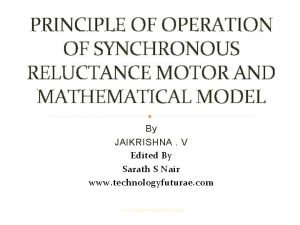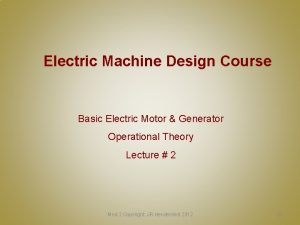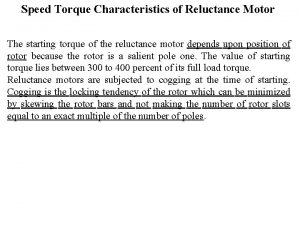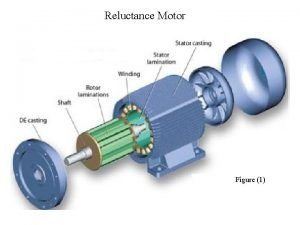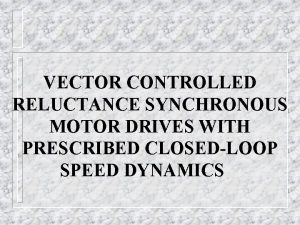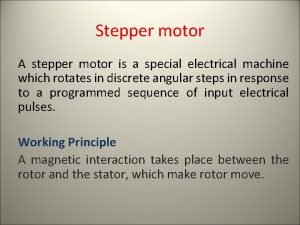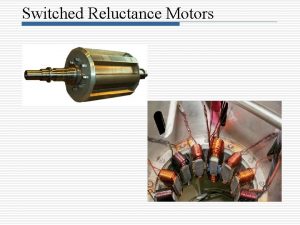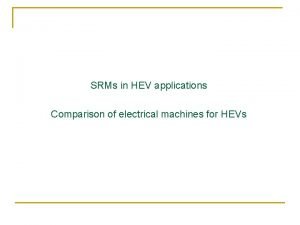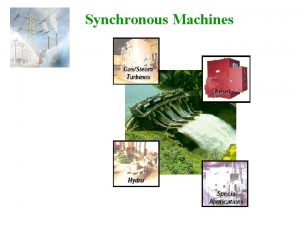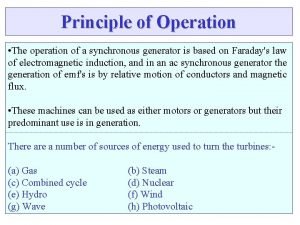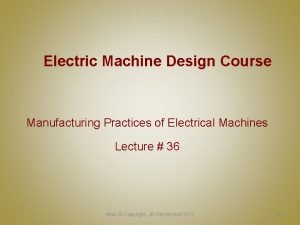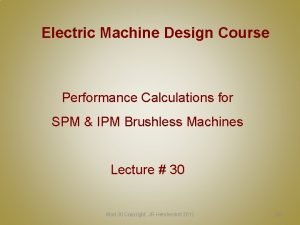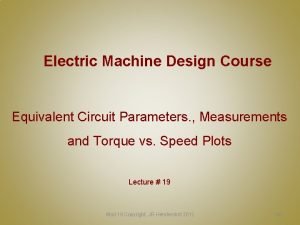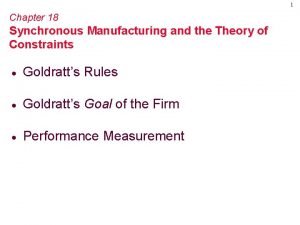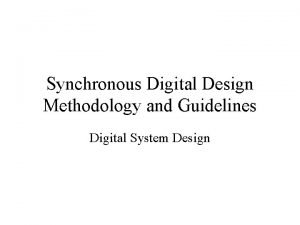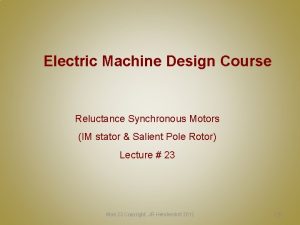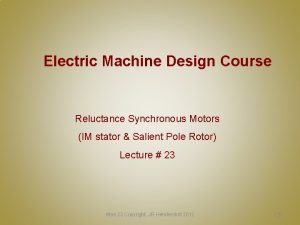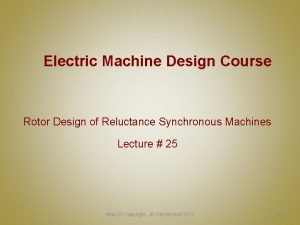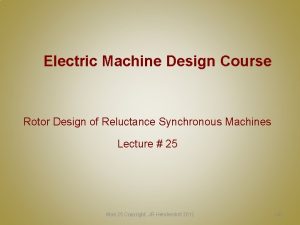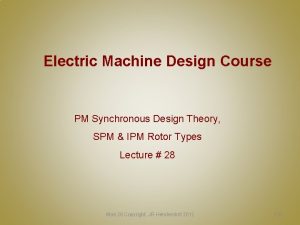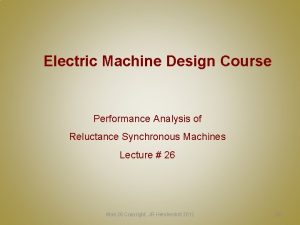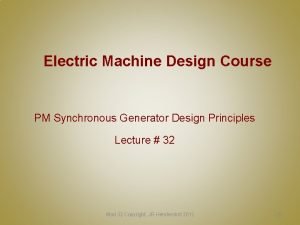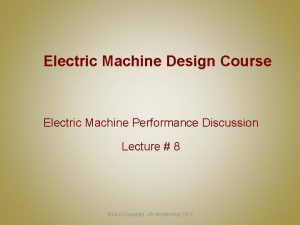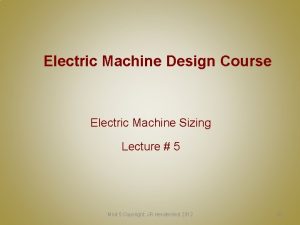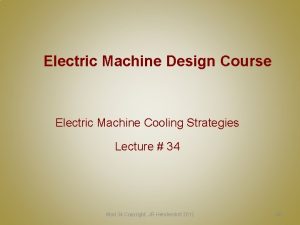Electric Machine Design Course Reluctance Synchronous Machine Theory
















- Slides: 16

Electric Machine Design Course Reluctance Synchronous Machine Theory Lecture # 24 Mod 24 Copyright: JR Hendershot 2012 230

Reluctance Synchronous machines ABB The RSM starts with a standard IM stator lamination and core with similar or same slot numbers per pole. The number of phase coils & arrangements are almost identical to those used for IM phase windings. This leads to the conclusion that standard IM frames and mechanical components are useful for RSMs with little or no modifications necessary. The rotor design of the RSM machine version must be optimized. Happily, no magnets are required (although optional) with no conductors & no intentional currents flowing in the rotor! (eddy currents unwelcomed) The only required task moving forward is to develop a rotor that must produce saliency in order to be attracted by the rotating electro-magnetic stator poles ! Mod 24 Copyright: JR Hendershot 2012 231

Photo taken from ABB web site Flux barrier/carrier proportions from an ABB advertising photo of their (4) pole Syn. RM product Flux carriers Flux barriers Carrier webs 232 Mod 24 Copyright: JR Hendershot 2012

So what goes on inside a RSM machine? The magnetic field set up by the NI in the phase coil causes an attraction of the rotor pole to be aligned to the stator axis. (CCW) Ld Each phase is independently controlled Lq The RSM has only a single multi-phase magnetic flux source (in stator) powered by an inverter. Torque is produced by attraction of salient rotor poles to the stator poles created by the (E) rotation of phase coils The level of attraction (torque) is proportional to Lq / L d Mod 24 Copyright: JR Hendershot 2012 233

RSM DEPENDENCE UPON Lq & Ld Mod 24 Copyright: JR Hendershot 2012 234

Equations that describe the D-Q equations Since we are using the same stator and inverter the windings are for the most part sinusoidally distributed. The stator leakage inductance is different than for the IM so the air-gap flux harmonics are handled with an additional term. Using Parks equations, the conventional equations of a synchronous machines are converted to the equation that describe the behavior of the RSM. Since there is only a single magnetic circuit there is no excitation field term. So we have the d-q equations for the RSM machine: = d axis inductance = q axis inductance rs = stator phase resistance = rotor speed 000 Mod 24 Copyright: JR Hendershot 2012 235

RSM motor power factor discussion The importance of a good power factor is well recognized. (So as not to require an oversized converter) RSM machines of the past have had limited success competing against IMs, SRMs & of course PMSM IPMs. Low saliency ratios between the d & q axes of early designs limited by low inductance ratios. The power factor of the RSM is given by cos φ In the rotating reference frame, Vqs & Vds are the q & d axes steady state voltages. The MMF angle is represented by ε Mod 24 Copyright: JR Hendershot 2012 236

RSM torque & power factor equations Therefore the electro-magnetic torque of the RSM machine is the same as for a synchronous machine: p = pole pairs The machines d & q axes values depends upon the size or the machine and the total number of conductors in the stator. The two inductance values vary with the square of the number of turns in series in the machine. (measured line to line) The inductance ratio depends upon the saliency ratio of the RSM (more about that coming up) which is set by the amount of air (flux barriers) and steel or iron (flux carrier) in the magnetic circuit the coil is linked with. Mod 24 Copyright: JR Hendershot 2012 237

Power factor vs. d & q axis saliency ratio As we have learned, the saliency ratio determines the d & q axis inductances. The d & q axis inductances determine the power factor. The power factor determines if RSMs can be useful. Put another way: can the RSM produce sufficient torque density or compete with other machine types? ABB has recently (Spring 2012) announced a broad RSM product line and claims the answer is YES! Mod 24 Copyright: JR Hendershot 2012 238

Relationship of saliency ratio to power factor Tom Lipo, Takayoshi Matsuo & Gary Horst have blessed us all with their work with RSMs in 1994 to provide us a good starting place for RSM design optimization of the rotor. They have answered the question as to the relationship between and power factor of the RSM machine. A plot of power factor vs. saliency ratio is provided by Matsuo & Lipo 1. 0 Power Factor Note: A power factor of 0. 8 requires a saliency ratio of about 7 to 1. 0 1 2 3 4 5 6 7 8 9 10 Saliency Ratio Mod 24 Copyright: JR Hendershot 2012 239

Design goal for a RSM rotor design The work summarized on the previous slide indicates some possibilities for this RSM motor type against AC induction machines. The infrastructure components are almost identical and the power converters are very similar to the IM products. A study of previous designs of RSM machines indicate difficulty in achieving saliency ratios above 3. 5 to 1 or so. Pro Lipo and Matsuo of the University of Wisconsin have created rotor configurations with acceptable saliency ratios that have been validated by actual prototype testing by Gary Horst of Emerson (now NIDEC) There are two principle known ways to create the saliency in the RSM These involve laminating either axially or radially with alternate flux barriers and flux carriers to control the permeability paths to create the poles. Mod 24 Copyright: JR Hendershot 2012 240

Axial & radial laminated RSM rotors q d d q Two most common RSM rotor configurations being developed for achieving maximum saliency ratio between d & q axes. Mod 24 Copyright: JR Hendershot 2012 241

Mechanical considerations Either lamination configuration must be rugged to withstand radial and torsional forces. The axial laminated rotor must have radial support webs in between the flux barriers and carriers to provide the required stability against forces The thicker these webs, the more rugged the rotor but the machine torque density is reduced from the leakage flux in these webs. The radial laminated designs are more rugged all around but each carrier is a different shape than the others (each set per pole is identical) The radial laminated barriers and carriers must be fastened to the rotor core and the use of threaded fasteners has been common. (High apparent cost) Bottom line here is: This is a great opportunity to be creative and inventive with new RSM rotor designs for high saliency and low cost. Mod 24 Copyright: JR Hendershot 2012 242

Use of magnets to increase torque density Although RSMs are intended to eliminate magnets, small slabs can be used to increase the torque density. Flux carriers & barriers Rotor stability requires retention of magnets against radial and tangential forces Layers of magnet slabs used as flux barriers Use of permanent magnet flux barriers should be avoided at all cost because the purpose of looking at RSMs was to avoid use of magnets University of Padova Mod 24 Copyright: JR Hendershot 2012 243

Title Mod 24 Copyright: JR Hendershot 2012 244

Title Mod 24 Copyright: JR Hendershot 2012 245
 Pmsm torque equation
Pmsm torque equation Motor design course
Motor design course Reluctance to simplify examples
Reluctance to simplify examples Torque speed characteristics of switched reluctance motor
Torque speed characteristics of switched reluctance motor What is reluctance torque
What is reluctance torque Switched reluctance motor
Switched reluctance motor Single stack variable reluctance stepper motor
Single stack variable reluctance stepper motor Torque speed characteristics of switched reluctance motor
Torque speed characteristics of switched reluctance motor Hendershot
Hendershot Power angle characteristics of synchronous machine
Power angle characteristics of synchronous machine What is load angle
What is load angle Electric machine design coaching
Electric machine design coaching Electric machine design training
Electric machine design training Electric machine design training
Electric machine design training Synchronous manufacturing and theory of constraints
Synchronous manufacturing and theory of constraints Synchronous digital system
Synchronous digital system Synchronous counter
Synchronous counter
